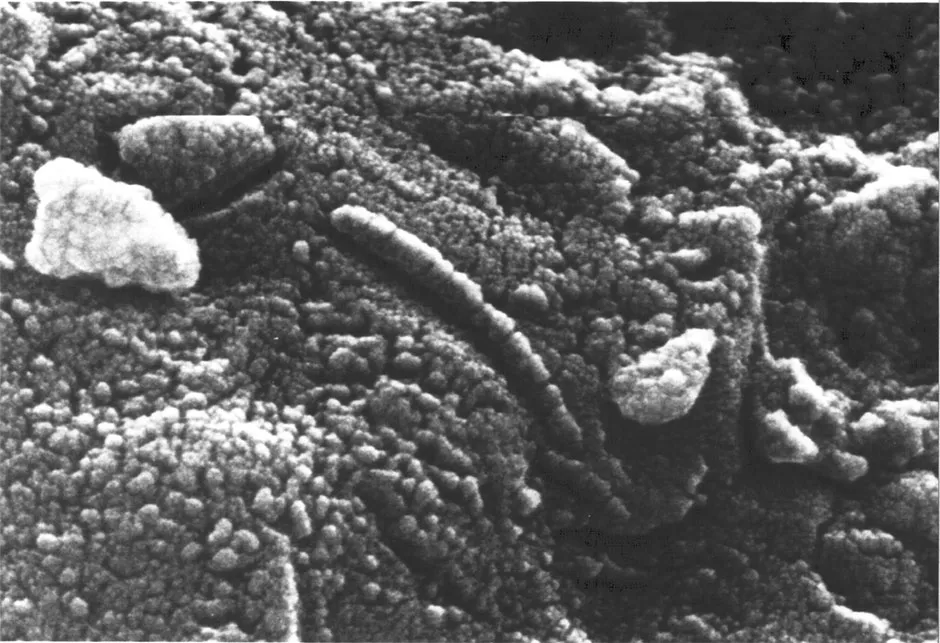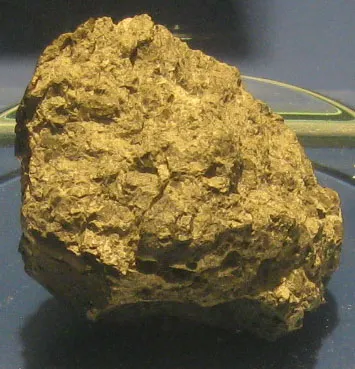27 December1984 was a warm summer day in Antarctica’s Far Western Icefield, with a lull in the normally biting winds and the temperature hovering as high as -20°C. The ice here forms a vast flat plain that dazzles in the sunlight and is tinted slightly blue.
Geologist Roberta Score and her colleagues spent the morning patrolling the area on snowmobiles, sweeping back and forth for hours in a search formation around 30 metres apart. The monotonous routine could numb the eyes and brain, so just before noon the team leader, John Schutt, called a break, and the group diverted to a nearby escarpment surrounded by ice pinnacles, carved by the wind, that look like giant, frozen waves.
After enjoying the view from the top of the ridge, the geologists rode back towards their search area, taking care to avoid chasms in the ice and windswept piles of snow. And that’s when Score saw it: a dark green spot against the glaring blue. She stopped her snowmobile and waved her arms to alert the others. Here, on this ancient untouched stretch of ice, was what they had been looking for: a messenger from the depths of space.
The rock, labelled ALH84001, was initially classified as an unremarkable chunk of asteroid and consigned to the laboratory stores. But a decade later, it would become a global sensation and a household name.
Read more about life on Mars:
- Astrogeology: How are we looking for life on Mars?
- Wild ideas in science: We've already found life on Mars
- Is there life on Mars? Here’s what we know
In 1993, researchers realised that ALH84001 is in fact from Mars, formed from volcanic lava over 4 billion years ago. That made it incredibly ancient, almost as old as the Solar System itself, more than three times as old as the next-oldest Mars meteorite, and significantly predating any rock known on Earth.
Studies of molecular signatures in the rock showed that it was ejected into space by an impact 16 million years ago, and drifted through the Solar System until 13,000 years ago, when it was captured by Earth’s gravity and landed in Antarctica.
NASA geochemists Chris Romanek and Everett Gibson studied unusual orange grains inside the meteorite, made of carbonate. On Earth, rocks containing carbonate commonly form in water, for example when shells and skeletons from marine creatures accumulate and fossilise.
Their results suggested that these Martian carbonates were deposited in the rock after carbon dioxide, dissolved in liquid water, flowed into tiny cracks. Today’s Mars has an average temperature of -60°C; ALH84001 pointed to a far more hospitable past. And that wasn’t all.
The pair also saw microscopic shapes near the carbonate grains: worms and sausages that looked just like Earth bacteria, except much smaller. It was the start of a crazy idea. Could water flowing into the rock have carried not just carbonates, but tiny Martian microbes?

In September 1994, Gibson and Romanek showed their images to senior NASA scientist David McKay. He joined them to pursue the idea, along with microscopy specialist Kathie Thomas-Keprta. ‘I kind of thought he was crazy,’ she said later, but she reluctantly agreed to help investigate the rock’s strange features.
Herplan at first was to save McKay and the others from embarrassment, to prove to them that there was no evidence of Martian life in ALH84001. As she scanned the meteorite’s microscopic terrain, with its orange moons embedded in the silver-grey rock, she became intrigued by tiny black grains in the rims of the carbonate globules, just nanometres across.
She found that they were magnetic crystals, made of magnetite (iron oxide) and pyrrhotite (iron sulphide), just like the tiny compasses produced by magnetotactic bacteria on Earth. There are non-biological ways to make these minerals, but this generally takes extreme conditions – high temperature and pH – so it was hard to explain how they ended up in carbonates deposited at mild temperatures. Unless these crystals were made by bacteria too.
In January 1995, the team received a visit from UCLA’s Bill Schopf, a world expert in fossil microbes, who had identified remains of the oldest-known life within 3.5-billion-year-old rocks on Earth. He was unimpressed by their evidence for alien bugs. You have no case unless you can show organic matter in the structures, he told the team.
It seemed a longshot: after all, NASA's 1976 Viking mission had found no organics on Mars. But Thomas-Keprta had already sent two flecks of ALH84001 to chemist Richard Zare at Stanford University. He had a powerful instrument called a laser mass spectrometer which could identify even trace amounts of chemical molecules by vaporising them.
Read more about extraterrestrial life:
- Possible signs of alien life detected in Venus’s atmosphere
- The weird worlds alien life could potentially survive on
Not wanting to give away what she was working on, she had sent the samples with code names, Mickey and Minnie; Zare and his colleagues, unimpressed by the subterfuge, duly left them on the shelf. But after Schopf’s visit, Thomas-Keprta finally persuaded them to take a look.
They found what Viking had failed to: organics from Mars. Complex organic molecules called polycyclic aromatic hydrocarbons (PAHs) were concentrated within the carbonate moons.
PAHs can form non-biologically – they’re in everything from car exhaust to interstellar gas clouds – but on Earth you also find them wherever life has been, for example in petroleum or coal. The molecules that Zare and his colleagues found in ALH84001 were exactly what you would expect to see when bacterial cells decay.
For the team, the coming together of so many potential fingerprints of life had to be more than a coincidence. In early 1996, with excitement combined with ‘gut-fluttering dread’ they submitted their paper to the prominent journal Science.
After weeks of scrutiny by a panel of reviewers (including an ageing Carl Sagan) it was accepted for publication, setting in train a sequence of events that reached the country’s highest levels of power. In July, the team was called into the office of NASA chief Dan Goldin, who grilled them for hours, then Goldin in turn was summoned to the White House to brief President Bill Clinton and Vice President Al Gore.
At a press conference on Wednesday 7 August, President Clinton addressed the world live from the White House Rose Garden. ‘Today, rock 84001 speaks to us across all those billions of years and millions of miles,’ he said. ‘It speaks of the possibility of life.’ If confirmed, he added, the implications ‘are as far-reaching and awe-inspiring as can be imagined’.
Then the TV networks switched to the packed main auditorium at NASA headquarters. McKay, Gibson, Zare, Thomas-Keprta and Schopf (to give a doubter’s view) were lined up on stage. In front of them was a small chunk of ALH84001 in a glass case, and a large crowd of eager reporters.
NASA chief Goldin addressed the cameras. The team’s work had ‘brought us to a day that may well go down in history,’ he said. ‘We’re now at the doorstep of the heavens. What a time to be alive.’
One by one, the team described their lines of evidence: the carbonates, magnetite crystals and organics. None was conclusive on its own, but taken together, the team argued, they were evidence for primitive life on early Mars.
They played an animation showing worm-like microbes on Mars swimming in water and becoming trapped in the build-up of carbonate deposits inside cracks in the rock, before the rock was sent spinning into space and eventually landed in Antarctica. Finally, to an audible gasp from the audience, they showed their images of the putative ‘fossils’ themselves.

Within days almost a million people had seen the Science paper online. NASA staff counted more than a thousand stories broadcast on ALH84001 in the first week. News crews lined up at the meteorite lab in Houston for a glimpse of the original rock, while the scale of overage in the world’s newspapers and magazines eclipsed even that of the first Moon landing. USA Today called it ‘the headline man has been waiting for since the first human eyes looked into the heavens’.
Not all the coverage was positive. A prominent Microsoft executive called ALH84001 ‘the biggest insult to the human species in almost 500 years’. Zare’s lab had to temporarily take down its website and contact details after religious fundamentalists complained that its research contradicted the Bible.
And with the reputation of their field at stake, many scientists, too, were gearing up for the furious response. Twenty years and dozens of studies later, the results have largely stood up to scrutiny: the consensus is now that the rock’s intriguing features did indeed form on Mars, with the carbonates deposited in a watery environment at temperatures around 25-30°C.
But whereas the NASA team is as convinced as ever that life is the most plausible explanation; critics insist they have failed to prove their case.
What everyone does agree on, though, is that the team’s work and the surge of interest that followed helped to shift NASA’s future course and to found a new scientific field – astrobiology, the study of extraterrrestrial life – that now extends far beyond this one agency. The multi-pronged research into ALH84001, says Gibson, provided ‘the guiding idea’.
Rather than considering ‘aliens’ in isolation, scientists from a broad range of disciplines – understanding how planets form, studying past life on Earth, detecting organics in clouds of interstellar gas – now work together with one overarching aim: to understand the cosmos as it relates to life.
Score’s Antarctic discovery, then, didn’t necessarily yield aliens. But our understanding of life – on Earth and in the wider cosmos – would never be the same.
The Human Cosmos:A Secret History of the Stars by Jo Marchant is out now (£16.99, Canongate).
- Buy now from Amazon UK or Waterstones
